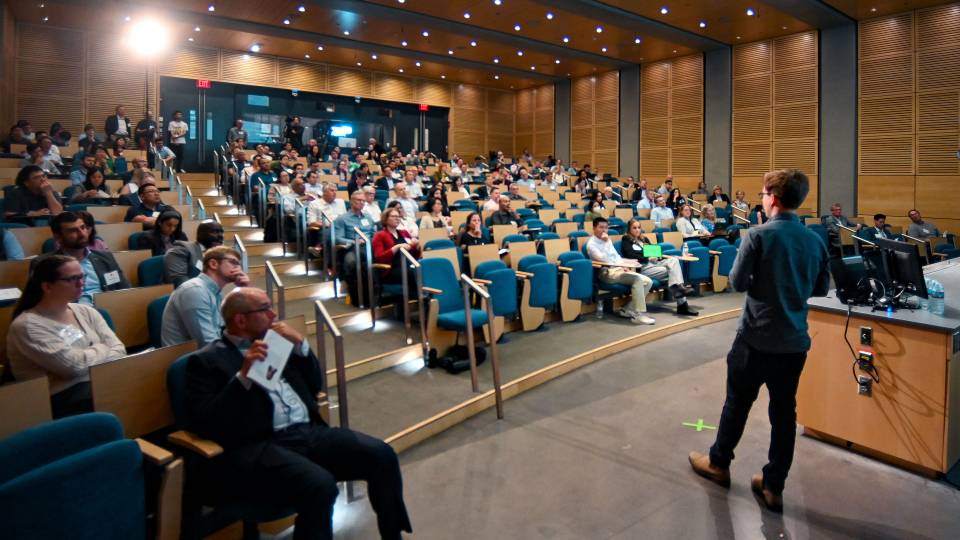The Princeton Catalysis Initiative(Link is external) (PCI) hosted its annual symposium of faculty “flash talks(Link is external)” late last month in an annual event that has become a premiere University forum for initiating collaborative research and attracting industry attention.
The May 24 symposium put Princeton faculty in a room with industry representatives, where 25 faculty presenters gave eight-minute talks that showcased the breadth of campus research: A smartphone-based app for testing brain function, a platform that uses the cold of space to cool the environment, bird-wing inspired engineering design, and many more.
In addition to generating excitement for blue-sky thinking in search of development, the talks have also become a valued opportunity for University researchers to ask colleagues across disciplines for an assist with their thorniest problems.
Vexed for years over how to test the limits of predictability in his work, Professor of Sociology Matthew Salganik(Link is external) made his appeal to the packed audience at Princeton Chemistry: “How do we study the limits of prediction? I think that is a fundamental question. I hope some of you somewhere in this room are thinking about this in your own field, because I would love to talk to you about how you might study it.”

Sociologist Matthew Salganik presents his flash talk, “ChatGPT for People and the Limits to Prediction” at Princeton Chemistry’s Taylor Auditorium.
Solving such research challenges of through collaboration is PCI’s founding credo and a formula that has proven itself in the six years since the initiative’s founding.
Back in 2017, a couple of chemistry professors wanted to know more about the research going on outside their own labs. The idea for a program shared by all researchers gained traction, and soon they secured University funding for the first PCI symposium. Their goals for the campus-wide initiative projected 150 cross-field collaborations with $10M in funding within a few years.
Today, 500 collaborations across 12 departments are backed by nearly $100M in committed funding.
Part of the appeal of PCI is accessibility. The flash talks encapsulate novel research while also posing intriguing questions in search of multidisciplinary solutions, and they make for stimulating theater.
During his presentation, Salganik displayed a slide with bar graphs on the predictability of life trajectories for at-risk children in Pittsburgh. But instead of drawing conclusions about the data itself, Salganik pointed to the empty space between the peaks and valleys.
“The dominant pattern here is this vast white space,” he said. “Instead of thinking about studying predictability systematically or trying to get predictability to incrementally increase, how do we study its limits? If you’re a policy maker and you have to make decisions about whether to use systems like this, a more basic question is, how predictable are these things? If they’re very predictable, that leads to one set of concerns, and if they’re not predictable at all, that leads to another.”
“He was just fantastic,” said Professor Sir David MacMillan(Link is external), the James S. McDonnell Distinguished University Professor of Chemistry, co-recipient of the 2021 Nobel Prize in Chemistry and a founding member of PCI. “What Matt was able to do was bring it all together in one absorbing presentation. That is exactly what PCI stands for: great research and great ideas looking for great partners.”
He continued: “When you realize there are whole research groups behind all of these individuals, you start to see how big the impact can be. I think this was the best PCI event to date.”
Mechanical and Aerospace Engineering Assistant Professor Aimy Wissa(Link is external)’s talk on “Bio-inspired Locomotion Strategies” featured a video on the balletic precision of birds in flight and how engineers can adapt their wing aerodynamics to the design of UAVs. Civil and Environmental Engineering Assistant Professor Jyotirmoy Mandal(Link is external) presented questions tailored to appeal to his inquisitive colleagues: “Can we design the ideal polymer or ceramic for radiative cooling at a molecular level?” and “How best can radiative coolers be deployed in resource poor settings?” And Ellen Zhong’s(Link is external) talk on “Machine Learning for Structural Biology” focused on developing algorithms that uncover protein dynamics.
“I thought the symposium was an extraordinary experience,” said Zhong, assistant professor of computer science. “The flash talk format provides this incredible, fast-paced cross-section of the research at Princeton. I was overwhelmed with all the interest in our work after the talk, and I’m excited to form new collaborations that both expand the scope of our research and let me learn about new areas.”

Left: Audience members enjoy the research flash talks at the Fifth Annual PCI Symposium on May 24. Right: Ellen Zhong, assistant professor of computer science, presents “Machine Learning for Structural Biology.”
An important goal of the symposium is connecting ideas with funding opportunities, so PCI’s six industry partners were all represented, attending both the flash talks and the dinner that followed. Janssen, the fourth corporate entity to sign a partnership with PCI, brought a number of company leaders.
“As Janssen enters our fifth year of PCI membership, we have benefitted from exceptional interactions with the Princeton University academic community,” said Tamar Grossman, vice president and global head of RNA, Gene Therapy and Delivery at Janssen. “We have supported 10 projects thus far, resulting in impactful publications and extensive knowledge sharing, and look forward to many more years of collaboration with Dave, Ian, and Princeton’s PCI network.”
Researchers interested in working with the Princeton Catalysis Initiative are encouraged to apply for funding, whether or not they attended the symposium, by contacting Ian Davies, director of PCI, at idavies@princeton.edu. Applications are due by June 30, 2023, and awards will be announced in July.
The Princeton Catalysis Initiative acknowledges generous support from Anthony Evnin ’62 and Eric ’76 and Wendy Schmidt through the Schmidt DataX Fund. View this year’s flash talks.(Link is external)






